
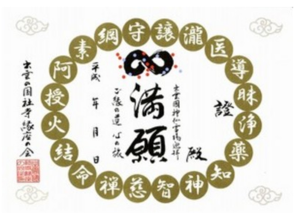
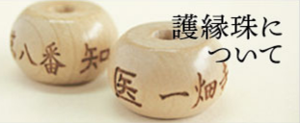
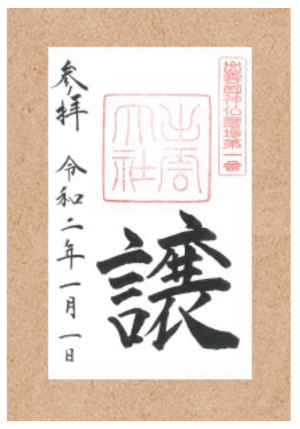

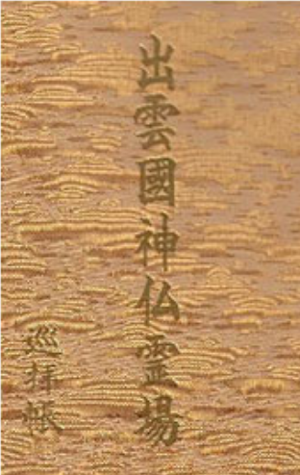
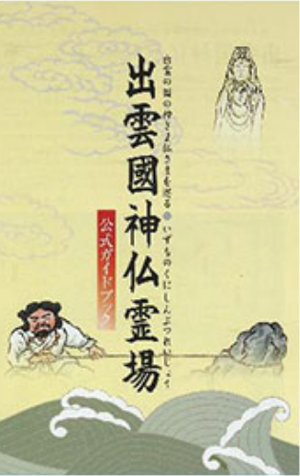
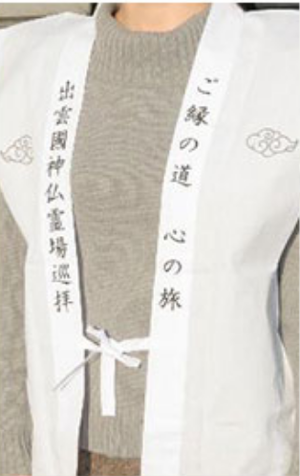
The Enza-no-kai Pilgrimage takes place in an area known as the birthplace of the Japanese spirit. The ancient province of Izumo in present-day Shimane Prefecture, appears in Japan’s ancient mythology and is reflected in its many old shrines and temples. Partly as a consequence of this history the 10th month of the lunar calendar in Japan is known as the "Month without Gods" (Kami-na-zuki), 神無月), however in Izumo it is known as the "Month with Gods" (Kami-ari-zuki), 神在月), because it is said that all the approximately 8 million gods (kami) in Japan descend on Izumo at this time of year to meet at the Izumo Taisha Shrine (Stop No. 1 on the pilgrimage).
The following is the position of the Enza-no-kai Pilgrimage: These days there are many occurrences which cast dark shadows over our lives and relationships and have an adverse effect on world peace. It is as if our souls, the very root of our existence, and our way of life is being questioned. Izumo is the perfect place for one to search within and find oneself living as part of the great universe. It is with pride and with the hope that many people will come together and make this spiritual journey, and that goodness will ripple out and spread further and further.
The Izumo area has beautiful scenery, with the sea, mountains and rivers surrounding Lake Shinji and Naka-umi Lagoon, and life is simple and spiritually rich.
Happiness is not just an emotion of the individual, but rather comes from the chain of hope between people all wanting to find happiness. For a long time the Izumo area has placed great importance on ‘en’, or the forces that connect us to one another, and we pray that this virtue will spread and touch all our hearts.
The official pilgrimage logo symbolizes the figure 8 pilgrimage route around Lake Shinji and Naka-umi Lagoon. The red spots are the shrines and the blue ones the temples. It is also a symbol of infinity spreading out into the future.
Note: For those wishing to make an "official" pilgrimage by visiting all 20 sites, it is recommended that you obtain a Pilgrimage Book (巡拝帳; ) at your first stop so each shrine/temple can put a "red stamp" (御朱印; shu-in) in the book to record your visit. In addition you will be given a wooden "bead" (護縁珠; go-in) by each shrine/temple. Please know that these items are not "free" but usually involve a fee ranging from JPY200 (for a Japanese guide pamphlet), to JPY500 (per red stamp & free bead), to JPY3,000 (for a pilgrimage vest, or a completion certificate).
The stamps bear the name and a character representing each shrine or temple and are proof of your visit. The wooden beads bear the same characters as the stamp carved into it. The beads accompany the stamps, and are not sold or given away separately. By visiting each shrine and temple and receiving each bead the circle of ‘en’ is completed. The beads are made from the wood of the Japanese cherry tree (sakura) and do not cause allergies even when in direct contact with the skin. They are made by traditional carving techniques used in local Unshu abacus producted in Okuizumo Town in Shimane Prefecture. You can arrange the beads in order of the pilgrimage or in the order of the route you took. The completed bead set is proof of your visit and makes a nice commemorative lucky charm. You can connect them together with a braid of "Musubi", and wear it as a talisman that can be hung from your neck.
If you wish to receive the Completeion Certificate (Mangan-no-sho), please complete the application form at the last shrine or temple of your visit. You may be asked to show your completed pilgrimage book or bead set as proof of finishing the pilgrimage. The certificate costs JPY3000. Please note that some shrines and temples are unable to provide the Completion Certificate. These are Gakuenji Temple, Ogamiyama Shrine Okunomiya, Daisenji Temple and Susa Shrine. Applicants will also receive a Mangan Magatama Bead (mangan means "the fulfillment of a vow or wish"). This is a bead made from agate with the words "Full Wish" inscribed on it, indicating your completion of the pilgrimage. You can tie this bead to the largest wooden bead on your completed bead set if you wish.
Note: Pilgrims walking between the 20 stops on the Enza-no-kai Pilgrimage will need to allow a minimum 13 days (assuming an 8 hour day, and a 2 hour stop at each shrine/temple), a total distance of 300 kilometers/187 miles, and an average altitude change of 212 meters/695 feet per leg of the journey, with a range of 9 meters/30 feet to 840 meters/2,756 feet.
See their website for details.
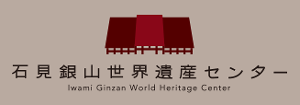
accommodations Yuzuriha Inn in Omori Town.
It should take about one-day. Once you select it and save it, you can change/customize it. If you plan to continue on, you can add other Sea of Japan itineraries starting from Matsue. Although we recommend beginning the string of Noto Peninsula itineraries from the Kanazawa Station (MapCode: 41 558 874*22), you can begin it from other nearby "gateways," e.g. the Komatsu Airport (MapCode: 120 529 748*33) or the Noto Satoyama Airport (MapCode: 283 475 067*52). All have several rental car outlets.
If you have extra time you can spend any extra time in Matsue enjoying the local public onsen (hot bath) at the XXXX at the east end of Matsue along the coastal highway #249. In the evening you should definitely take in a performance of the XXXX at the XXXX (MapCode: 283 800 875*25). Nightly performances are at 21:10.
ACCOMMODATIONS: There are a variety of accommodation options in Matsue City where you can spend the night, if you wish. There are considerably less accommodation options, other than local minshukus (B. & Bs.), outside Matsue City. One of the nicer hotels/ryokans in Matsue is the refined XXXX (MapCode: 329 193 788*85) with its own onsen, located to the east of the city proper. Another noteworthy option further to the east is the beautiful XXXX (MapCode: 913 056 436*47), an isolated, 15-room ryokan located right on the northeast Noto coast.
You can also easily reverse the itinerary, if you wish, just by following the MapCodes in the reverse order.
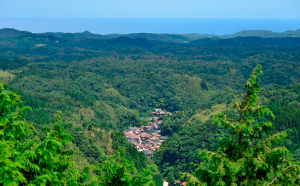
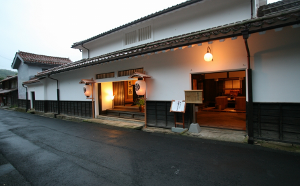


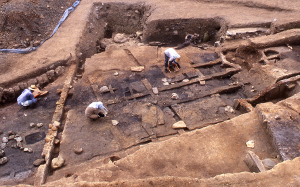
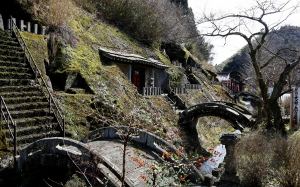
Omori Village (Omori-cho or Omori-machi) is an historic small village in the heart of the Iwami Ginzan Silver Mine area (1526-1923). There is an approximately 1.5 km/1 mi long main street with historic buildings, shops, museums, shrines, temple, accommodations, etc. As there isn't room to park along the street it is best to park at this central parking area (Iwami Ginzan Public Parking Lot, MapCode: 599 113 262*85) and walk around the town. Normally a visitor will enter from the east end of town (MapCode: 599 144 274*71) and drive to the parking lot. Keep in mind that this is an actual town so be respectful of people's privacy and property. Starting at the east end of the village some of the notable sites are:
The Miyanomae Refinery Ruins was built between the end of the 16th century and the beginning of the 17th century. It was discovered near the Daikansho (Iwami Ginzan Museum) Site in the Omori Zone. There are only archeological remains today. (MapCode: 599 144 367*74)
The The Kigami Shrine can be considered the spiritual anchor of Omori. The shrine was established in its current location in 1577, when the ruling Mori family had it built to protect the town and its residents from misfortune. The sanctuary, along with much of the rest of Omori, was destroyed in a great fire in 1800 and then rebuilt 12 years later. The current buildings date back to this reconstruction and include an imposing two-story worship hall (haiden) with a distinctive hip-and-gable roof. Part of the hall is decorated with the family emblems of samurai who made donations to the shrine, but the most impressive feature of its interior is arguably the nakiryu (“roaring dragon”). This ceiling mural from 1818 represents a dragon in flight and, thanks to some ingenious acoustics, “roars” if you clap your hands while standing directly underneath it. (MapCode: 599 144 303*52)
The Iwami Ginzan Museum originally was the office of the local representative of the shogun . (MapCode: )
The Kumagai Family Residence belonged to the Kumagai family, who for centuries were the richest and most influential in Omori. They began expanding their authority in the early 1600s, after the silver mine and the lands surrounding it were seized by the Tokugawa shogunate, which was to rule Japan until 1867. The family made its fortune in mining but later diversified to include financial and contracting services for the magistrate’s office, which represented the central government in the region. At least since 1718 a member of the Kumagai family was the official tasked with weighing silver to determine its purity and collecting payments from miners whose product was found lacking in quality. This function was a crucial part of the government’s taxation activities, so the Kumagai family were well compensated for performing it. The buildings were used as a residence until the end of the 20th century and then restored to resemble its appearance in 1868. The residence gives visitors a sense of how an affluent merchant family lived when Iwami Ginzan was at the height of its prosperity. (MapCode: 599 143 119*71)
The Arata Barbershop is a traditional 20th century Japanese barbershop. (MapCode: 599 143 057*58)
The . (MapCode: )
The . (MapCode: )
The . (MapCode: )
The town of Omori has functioned as the administrative and commercial hub of Iwami Ginzan since the early 1600s. This was when the Tokugawa clan, which by 1603 had vanquished most of its rival warlords and founded the shogunate that was to rule Japan until 1867, established an office for its magistrate in charge of local affairs at the foot of the mountain. A town sprang up around the magistrate’s office, with merchants and samurai moving in to satisfy the office’s demand for goods and services. This created further employment opportunities, and the town’s population continued to increase.
Diverse Townscape
Omori’s relatively small area and sudden development resulted in a peculiarly mixed urban structure, with the houses of samurai, tradespeople, and commoners, along with shrines and temples, intermingling in close proximity. This was a rarity in feudal Japan, where the social classes usually lived in separate neighborhoods. Although most of the town was destroyed in a fire in 1800, this patchwork distribution of land remains the distinguishing feature of Omori. Walking through the town, you will see that the former samurai residences have gardens between the houses and the street, whereas most shops and multiple-unit dwellings front on the thoroughfare. In the Edo period (1603–1867), gardens were a sign of status, but they could also be used for practical purposes: some of the samurai households built small structures in the gardens and rented them to bring in additional income.
Red Tiles and Plum Trees
Omori is also known for the red tiles used on many of the town’s roofs. Made from the iron-rich clay found in the area, these sekishu-kawara (“Sekishu tiles”; Sekishu is another name for the Iwami area) are common throughout the Chugoku region, where Shimane Prefecture is located. Looking out over the town from above, you will notice that many of the larger buildings have gray roofs. Such structures tend to be traditional samurai residences or administrative facilities; gray tiles were favored by the warrior class as a symbol of authority. Another visual feature of the town is its ume plum trees, many of which were planted when the silver mine was still active. Miners believed that the citric acid in pickled plums would help them stay alert in the dusty shafts, so they would stick these fruit inside their masks when they entered the mines.
Visiting Omori Today
Although the town of Omori has been designated a historic district and is protected from development, some of the old buildings have been put to innovative uses. A good example is Gungendo, a shop, cafe, and gallery housed in a renovated Edo-period farmhouse, where you can purchase clothing and local food, view artwork, and sit down for lunch or a snack while gazing at the garden.
Omori is a historic town that is happy to welcome visitors as long as its residents’ privacy and way of life are respected. Please refrain from entering homes or taking pictures of the residents without permission.
